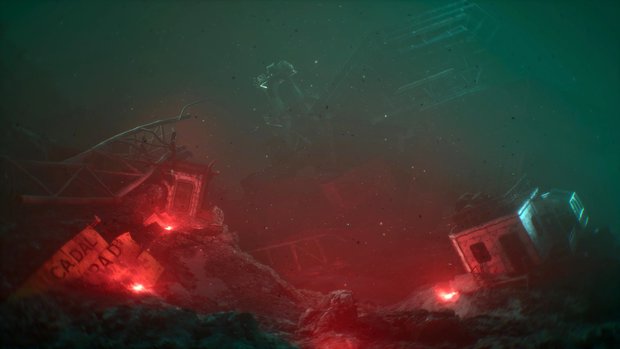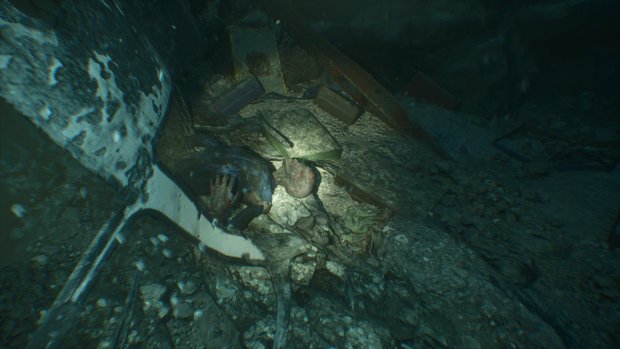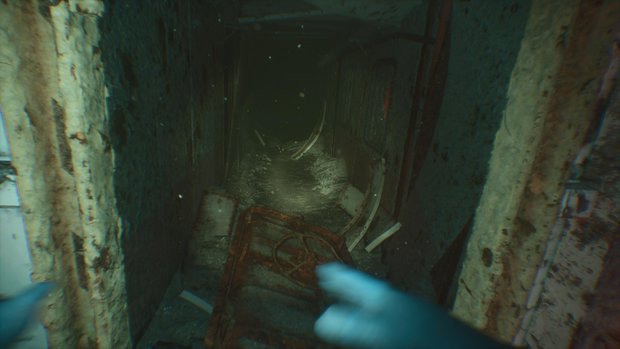Still Wakes the Deep: Siren’s Rest (DLC) review

- 0 Comments
The epilogue chapter set ten years later goes to darker places but isn’t quite able to rise to the level of its predecessor
Last year, The Chinese Room plunged players into Still Wakes the Deep, taking their familiar gameplay-lite formula and injecting it with a creepy, Lovecraftian vibe, along with more frantic pacing that really elevated its narrative about a 1970s offshore oil rig beset by supernatural forces amidst a devastating storm. Now we can dive right back in deeper than ever with the game’s DLC spin-off episode. Siren’s Rest aims to recapture the original’s uneasy sense of impending doom, this time with an added element of underwater claustrophobia, but ends up presenting a tangential story that sadly feels a little bare-bones and, to put it bluntly, skippable.
Ten years have passed since the events on the Beira D, and the tragic fate of the rig and her crew still haunt the families and loved ones of those who perished. This time players take on the role of Mhairi, a member of a saturation dive to the bottom of the North Sea to find the sunken wreckage and explore its depths to once and for all record an account of why it vanished so suddenly and what it left behind. Though we aren’t told too much out of the gate, it quickly becomes apparent from comments made by Mhairi and her team that there is an ulterior personal motive for her to be on this dive, a deeper connection to the events that transpired than she initially lets on.
It doesn’t take long for the veil to be lifted on this particular secret – the whole episode only lasts about two or three hours across three chapters – and I found the connective tissue tying them together to lack dramatic impact. The base game focused so much on its protagonist Caz that I barely recalled any recurring characters or names, despite having replayed it the previous day to refresh my memory! Most Beira D crew members were never that fleshed out to begin with, being little more than window dressing that felt interchangeable and were often polished off just as quickly as they appeared. This resulted in little emotional attachment to anybody outside of Caz’s immediate circle, so a game about a mysterious newcomer who is somehow connected to one of them – who it actually is never really mattered to me – had an uphill battle to get me fully invested. There is at least a satisfying climactic scene to be had, capitalizing on the greater tragedy of the Beira’s crew as a whole, but Mhairi’s individual plight just never hit home with me.

Though Siren’s Rest may not hit all the right notes as a narrative extension to Still Wakes the Deep, the episode does work well enough in a self-contained capacity. It provides a good amount of moody atmosphere and even some tension as Mhairi braves the crushing depths of the North Sea to explore what’s essentially a ghost ship – one that we already know was haunted by several gruesome horrors. As she descends into the alien and unwelcoming underwater setting, she finds herself completely at the mercy of a hostile environment that could kill her in a thousand ways, from sudden rock slides caving in the corroding structure to being buried under tons of rubble or trapped inside with no way out – not to mention any creatures that may or may not still be around.
But Mhairi doesn’t know about those…yet. As far as she’s concerned, she’s on this dive to gather any surviving personal artifacts from the wreckage in order to return them to the bereft families of the victims, as well as to bring back photographic proof of any bodies she comes across along the way. As she must travel light, she only has a crowbar to breach stuck doors or lockers, plus an arc torch to loosen the rust on stubborn metal grates or hatches.
For the majority of the game, we find ourselves swimming through the submerged hallways and rooms after gaining entry into the facility. While this is essentially a similar gameplay loop to the original, where we made our way through these same places on foot, the fact that it now happens underwater of course changes how we move about. Much like games set in zero-G of outer space, it’s a simple matter of pointing the first-person camera where you want to go and pressing a button to propel yourself in that direction. Sure, the range of movement is greater, but the natural water resistance does make it a slower, more plodding process, with fast-paced action scenes largely absent, though there are certain handholds Mhairi can use to boost herself forward quickly in a pinch. It works well enough, though an option to roll along Mhairi’s axis would have helped me come to grips with the often unnatural angles the structure is canted at.

There is also one final, vital piece of Mhairi’s underwater diving equipment: the umbilicus that stretches out behind her and connects back to her diving bell a good distance away. Not only is this (presumably) needed to feed oxygen to her suit, it also – and more crucially to the game’s atmosphere – keeps her in constant radio contact with her support team. This means that even in the darkest recesses of this aquatic tomb, you have the comfort of knowing you’re not entirely alone in the ocean depths, and gives Mhairi someone to bounce her inner thoughts off during automatically unfolding conversations. The umbilicus is even more noticeable when it isn’t there, since Mhairi is occasionally forced to disconnect from it. (I won’t spoil why.) Being cut off from this literal lifeline and the last vestiges of human companionship, as distant as it is, has an immense impact on your psyche, ratcheting up the tension of isolation, having to deal with what may be hiding in the deep on your own.
Unfortunately, the umbilicus also led to a few moments of frustration for me. First, the idea of an impossibly long umbilicus stretching across the sea bed and twisting and turning through the passages of the Beira D is incredibly silly, so much that there is even a full dialogue exchange raising this very fact. Worse are the technical issues that come with this miles-long floating strand, which has a tendency to jitter around in space or clip through walls in its effort to trace a path back the way you came, slightly breaking immersion. Worst by far, however, was the time I got softlocked and had to completely restart the entire episode after dying and finding that my umbilicus had neglected to respawn back into the world with me. This wasn’t an issue at first, but a few minutes later when I needed to disconnect from it for story purposes, I suddenly had nothing to disconnect from. Hopefully this issue has been addressed since the pre-release version of the game I played.
While that may have been the only time I hit a dead end, dying is very much a part of Siren’s Rest. Not that death is that much of an inconvenience – you’ll just restart from a recent checkpoint, at worst setting you back a minute or two. But a good chunk of these life-or-death moments feel awkwardly implemented, probably due to the fact that the original’s run-and-hide gameplay is a bit trickier to pull off when transposing it into an aquatic environment. The only way to move quickly is by passing within reach – and pressing a button at just the right moment – of the previously mentioned handholds, and missing one can easily lead to Mhairi suffering a watery death.
Towards the end of the episode, there is even an enemy that patrols the area – something has survived the Beira’s sinking, and has been waiting patiently for company. It will mercilessly chase Mhairi and must be avoided, which plays out in a way that can charitably be called clunky at best. It can be hard to know when you’re in cover, and equally difficult to know which way to go to make a getaway, calling for a guess-and-repeat strategy. There was even a time – and I’m not making this up – I was peacefully swimming along when I suddenly died, several times, always in the same spot, without any clue as to why. Eventually I figured out that I had apparently entered a surprise stealth section and was traipsing right into full view of the enemy, which I never even caught a glimpse of until my fourth or fifth attempt. Death may be forgiving in Siren’s Rest, but the guess factor attached to its do-or-die scenarios saps both the thrill and enjoyment out of them.

Things don’t look quite as nice this time around either. While Still Wakes the Deep was by no means a graphical powerhouse, the Beira D was lovingly crafted with attention to detail and felt like a real place – cozy at times, industrial and lethal at others. By comparison, there’s little in Siren’s Rest for your eyes to feast on. Yes, you’re underwater, in the dark, and the collapsed old oil rig is now rusty and blown to smithereens, but that also means there’s just not much to impress visually as you explore. It looks realistic enough, but in this case realism comes at the price of color and splendor. It’s all rather workmanlike, with utility in mind rather than beauty. Not that you’ll need to do much work, as there are very few ways to interact with the environment, other than forcing open doors and lockers. Like the original, there are no puzzles, so you usually just deal with and move past obstacles, only here they’re ugly and decaying.
Thankfully this episode does maintain the base game’s commitment to an excellent audio experience, particularly when it comes to its voice cast. Though there are only a handful of characters, the actors for Mhairi and her diving team turn in noteworthy performances, with authentic Scottish Gaelic accents and occasional phrases to boot. Subtitles really are all but required, not just to cut through the accents but also because most of the conversations occur via sometimes muffled or static-y radio transmissions. (Like in the original, the subtitles themselves can be set to match the voices specifically or to display more plain-speaking English.)
Music does its part in supporting the uneasy atmosphere (even without added hazards, searching a disaster site for corpses is never a carefree day in the sun), in between ramping up to underscore atmospheric moments of danger or suspense. The sound design also includes lots of effects that make the underwater scene complete, particularly the many ambient noises one might expect in a submerged tomb like the Beira D, though here they make your imagination work overtime deciding whether it’s the structure naturally groaning as it shifts and settles or some nearby Lovecraftian horror waiting to rip your face off.
Final Verdict
Still Wakes the Deep was a greatly enjoyable Lovecraftian horror story that was easy to get lost in for a spell, and I enjoyed it just as much my second time through. So you’d think that getting more of that world, even in a more digestible bite-size serving, would be an immediate slam dunk. But Siren’s Rest is less rewarding as a narrative capstone because it’s hard to connect to the new main character or her plight. And while the underwater setting may be atmospheric, it isn’t fun to traverse, even without the notable technical issues I experienced, making the already lite gameplay feel like it’s taken another half-step backwards. This epilogue chapter was clearly willing to sacrifice player interaction to match the emotional depth of its underwater setting, but in doing so ends up splashing around in the shallow end of the pool instead.
Hot take
As a bite-sized new dive into the world of Still Wakes the Deep, Siren’s Rest doesn’t quite measure up and will likely leave you hungering for the meatier, more fulfilling experience of the base game.
Pros
- Exploring the sunken wreckage ten years later is an intriguing concept
- Being constantly submerged creates plenty of tension
- Voice acting is excellent once again
Cons
- Underwater setting is bland and dreary to look at
- Emotional hook fails to deliver a satisfying connection to the base game
- Gameplay that worked well before struggles to find solid footing here
Pascal played Still Wakes the Deep: Siren’s Rest on PlayStation 5 using a review code provided by the game's publisher.













0 Comments
Want to join the discussion? Leave a comment as guest, sign in or register.
Leave a comment